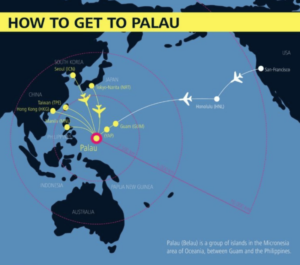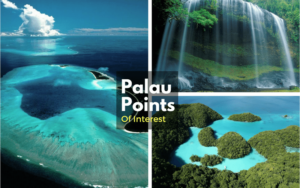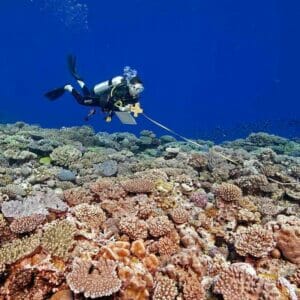Wondering what we think are 7 of the best dive sites in Palau? Scroll down, sit back, read and enjoy the show. Found in the western Pacific Ocean, Palau is one of the most beautiful island destinations on the planet and also one that is renowned for its incredibly diverse dive sites. Divers of all experience levels can enjoy a variety of experiences beneath the surface of the waves, from wreck dives to reef dives and drift dives. If you are looking for a new place to explore, consider Palau for your next diving trip. The currents at Ulong Channel can be unpredictable and strong, and it’s not uncommon to experience abruptly changing currents midway through a dive. Stick close to your guide, since you may have to turn around. The best time to dive Ulong Channel is on an incoming tide when the current is strongest. The water will be the clearest with a visibility of up to 95 feet (30m). Drop down into Ulong Channel to 60 feet (20m) and drift for about 10 minutes before hitting the mouth of the channel. It is here at the mouth of the channel where the stingrays, grey reef sharks, schools of snappers and jacks and the elegant batfish can be seen gliding past. Also read: Dive Ulong Channel | Unhook and Ride the Sweeping Current #4. Peleliu Wall Peleliu Wall is one of the most beautiful and deepest wall dives in all of Palau. Home to deep canyons and crevices, Peleliu Wall is known for its large pelagic action, and its steep walls are covered with large sea fans and beautiful corals. At Peleliu Wall, you can experience a wilder dive because this site is found off the island of Peleliu, which is one of the islands located the furthest distance from Palau. This is also one of the deepest dive sites in Palau, featuring canyons, caves, and crevices that shelter myriad marine species. A dive crew will be able to get you to this site, which is the perfect place to experience large “blue water” species, such as pygmy killer whales, silvertip sharks, and other large fish. Read more about diving Peleliu wall #5. New Drop Off Two separate reef walls come together at New Drop Off, so you will be able to explore the many corals and fish that swim throughout this incredible corner under the sea. Whitetip sharks and grey reef sharks can be seen here, as well as eels, turtles, and schools of fish that include wrasses, snappers, angelfish, and others. Divers who are inexperienced can get away with exploring this site when there is no current, but if the currents are strong, this site is best for only experienced divers who are confident enough to stay safe. #6. Chandelier Cave The Chandelier Cave provides a dive that is out of this world, but might not be for divers that do not like closed spaces, are claustrophobic or uncomfortable diving in the dark. This small cave system consists of 5 connected caves, four of which can easily be explored during the dive. The fifth chamber is a little trickier. Each chamber has fresh air, so it is possible to surface, take the regulator out and breathe.
The currents at Ulong Channel can be unpredictable and strong, and it’s not uncommon to experience abruptly changing currents midway through a dive. Stick close to your guide, since you may have to turn around. The best time to dive Ulong Channel is on an incoming tide when the current is strongest. The water will be the clearest with a visibility of up to 95 feet (30m). Drop down into Ulong Channel to 60 feet (20m) and drift for about 10 minutes before hitting the mouth of the channel. It is here at the mouth of the channel where the stingrays, grey reef sharks, schools of snappers and jacks and the elegant batfish can be seen gliding past. Also read: Dive Ulong Channel | Unhook and Ride the Sweeping Current #4. Peleliu Wall Peleliu Wall is one of the most beautiful and deepest wall dives in all of Palau. Home to deep canyons and crevices, Peleliu Wall is known for its large pelagic action, and its steep walls are covered with large sea fans and beautiful corals. At Peleliu Wall, you can experience a wilder dive because this site is found off the island of Peleliu, which is one of the islands located the furthest distance from Palau. This is also one of the deepest dive sites in Palau, featuring canyons, caves, and crevices that shelter myriad marine species. A dive crew will be able to get you to this site, which is the perfect place to experience large “blue water” species, such as pygmy killer whales, silvertip sharks, and other large fish. Read more about diving Peleliu wall #5. New Drop Off Two separate reef walls come together at New Drop Off, so you will be able to explore the many corals and fish that swim throughout this incredible corner under the sea. Whitetip sharks and grey reef sharks can be seen here, as well as eels, turtles, and schools of fish that include wrasses, snappers, angelfish, and others. Divers who are inexperienced can get away with exploring this site when there is no current, but if the currents are strong, this site is best for only experienced divers who are confident enough to stay safe. #6. Chandelier Cave The Chandelier Cave provides a dive that is out of this world, but might not be for divers that do not like closed spaces, are claustrophobic or uncomfortable diving in the dark. This small cave system consists of 5 connected caves, four of which can easily be explored during the dive. The fifth chamber is a little trickier. Each chamber has fresh air, so it is possible to surface, take the regulator out and breathe.  Underwater visibility in the caves is normally fantastic if the bottom remains undisturbed. Each chamber is filled with the strangest stalactites and limestone formations that have formed over the millennia, and resemble beautiful chandeliers, hence the name Chandelier Cave. In the caves, you can find shrimps and crabs living in the sponges, and if you are lucky, you might even see the elusive Mandarin Fish. Maximum depth for this dive is around 10m. If you turn off your torch, you will first be plunged into complete darkness, but be patient and after a couple of minutes, the entrance to the cave will reveal itself in a faint glow.
Maybe not a dive for people that do not like confined spaces, but definitely an unforgettable one! #7. Helmet Wreck And of course, there is also enough to see for all those of you who like to have a glimpse into the past by exploring wrecks. There are actually quite a few scattered around Palau, but the Helmet Wreck is always a favorite with divers from around the world.
It rests on a slope with the bow deeper than the stern. Maximum depth for this wreck is around 30 m; the uppermost part rests in only 10 m of water. The wreck sits upright on the seafloor and is completely encrusted in various corals. There are a lot of things to see and discover, for example, the gun barrel and gun mount.
Underwater visibility in the caves is normally fantastic if the bottom remains undisturbed. Each chamber is filled with the strangest stalactites and limestone formations that have formed over the millennia, and resemble beautiful chandeliers, hence the name Chandelier Cave. In the caves, you can find shrimps and crabs living in the sponges, and if you are lucky, you might even see the elusive Mandarin Fish. Maximum depth for this dive is around 10m. If you turn off your torch, you will first be plunged into complete darkness, but be patient and after a couple of minutes, the entrance to the cave will reveal itself in a faint glow.
Maybe not a dive for people that do not like confined spaces, but definitely an unforgettable one! #7. Helmet Wreck And of course, there is also enough to see for all those of you who like to have a glimpse into the past by exploring wrecks. There are actually quite a few scattered around Palau, but the Helmet Wreck is always a favorite with divers from around the world.
It rests on a slope with the bow deeper than the stern. Maximum depth for this wreck is around 30 m; the uppermost part rests in only 10 m of water. The wreck sits upright on the seafloor and is completely encrusted in various corals. There are a lot of things to see and discover, for example, the gun barrel and gun mount.  The wreck sits upright on the seafloor and is completely encrusted in various corals. There are a lot of things to see and discover, for example, the gun barrel and gun mount. The small supply vessel has been hit on the starboard side, and the explosion left a massive hole, giving access to the main cargo hold. You will find throughout the wreck, piles of ammunition, rifles, and helmets. These last ones give the wreck its name. The vessels real name is unknown. It was most likely confiscated in South East Asia during WW2. Its wreck was discovered fairly recently in1990 and so far any attempt to find out the ships real name has remained fruitless. The wreck is about 180 feet/60 m long, and 30 feet/10 m wide and remains fairly intact in large areas. It can be penetrated, but of course, you need the proper training and experience. Due to its proximity to the reef and the silty bottom, visibility is not always good. Please take care when diving the wreck and do not pick up any ammunition, etc., since the years in the water have rendered it unstable, and it might explode. #8. The Jellyfish Lake Some people might wonder, why the famous Jellyfish Lake does not feature amongst the best dive sites in Palau. There are a few reasons for that, the most important one, that it is not actually a dive site. Only snorkeling is allowed to preserve the delicate ecosystem of the lake, which has been gravely disturbed by the recent drought, eradicating most of the jellyfish in Jellyfish Lake. It is now until further notice completely closed for touristic traffic. Luckily, Palau has so much more to offer! Only snorkeling is allowed to preserve the delicate ecosystem of the lake, which has been gravely disturbed by the recent drought in 2016, killing most of the jellyfish in Jellyfish Lake. The lake and jellyfish are slowly recovering, time will tell if it makes a full reovery. Luckily, Palau has so much more to offer!
The wreck sits upright on the seafloor and is completely encrusted in various corals. There are a lot of things to see and discover, for example, the gun barrel and gun mount. The small supply vessel has been hit on the starboard side, and the explosion left a massive hole, giving access to the main cargo hold. You will find throughout the wreck, piles of ammunition, rifles, and helmets. These last ones give the wreck its name. The vessels real name is unknown. It was most likely confiscated in South East Asia during WW2. Its wreck was discovered fairly recently in1990 and so far any attempt to find out the ships real name has remained fruitless. The wreck is about 180 feet/60 m long, and 30 feet/10 m wide and remains fairly intact in large areas. It can be penetrated, but of course, you need the proper training and experience. Due to its proximity to the reef and the silty bottom, visibility is not always good. Please take care when diving the wreck and do not pick up any ammunition, etc., since the years in the water have rendered it unstable, and it might explode. #8. The Jellyfish Lake Some people might wonder, why the famous Jellyfish Lake does not feature amongst the best dive sites in Palau. There are a few reasons for that, the most important one, that it is not actually a dive site. Only snorkeling is allowed to preserve the delicate ecosystem of the lake, which has been gravely disturbed by the recent drought, eradicating most of the jellyfish in Jellyfish Lake. It is now until further notice completely closed for touristic traffic. Luckily, Palau has so much more to offer! Only snorkeling is allowed to preserve the delicate ecosystem of the lake, which has been gravely disturbed by the recent drought in 2016, killing most of the jellyfish in Jellyfish Lake. The lake and jellyfish are slowly recovering, time will tell if it makes a full reovery. Luckily, Palau has so much more to offer!  Please feel free to contact us directly if you have any questions. We would love to hear from you.
Please feel free to contact us directly if you have any questions. We would love to hear from you.
Palau Diving Season
The Palau diving season is all year round, but if you can choose, the best time to dive Palau is during the “dry” season, between October and June. Since Palau is in the Tropics, it receives a fair amount of rain all year round, most of which luckily comes down during the night. The months between July and September bring a little more rain than usual, so this is Palau’s “rainy” season. Table of Contents 1. Blue Corner 2. German Channel 3. Ulong Channel 4. Peleliu Wall 5. New Drop Off 6. Chandelier Cave 7. Helmet Wreck 8. Note about the Jellyfish Lake Found in the western Pacific Ocean, Palau is one of the most beautiful island destinations on the planet and also one that is renowned for its incredibly diverse dive sites. Divers of all experience levels can enjoy a variety of experiences beneath the surface of the waves, from wreck dives to reef dives and drift dives. If you are looking for a new place to explore, consider diving in Palau for your adventure.Below are just 7 of the Best Dive Sites in Palau.
#1. Blue Corner Blue Corner is the most highly requested dive site in Palau and one of the most well-known dive sites on the planet. The unpredictable currents throughout the site are quite strong, though, so this site is best reserved for advanced divers only. Look for gorgonian fans, soft corals, anemones, and eels along the wall at the beginning of your dive. Once you reach 11 to 18 meters in depth, you will immediately notice that the currents become even stronger and, even though you may have seen a shark cruising by a few minutes ago, you will see even more of them now. If you manage to use your reef hook, you can then begin steadying yourself and floating as more sharks, including grey reef sharks and white tip sharks, start swimming quite close to you. #2. German Channel German miners created this channel during the early part of the 20th century. Since then, coral formations have made the channel quite narrow, to the point that even liveaboards have trouble making their way to the area at times. German Channel Wall is where all the great diving happens, where a sandy bottom greets you at 17 meters deep before sloping into even greater depths. The best part of the dive, in addition to the colorful coral, is a large number of manta rays and the gray reef sharks that can often be seen here. Also read: How Bird Shit Made German Channel an Epic Dive Site? #3. Ulong Channel Ulong Channel is considered one of the best drift dive sites on the planet; its entrance is filled with beautiful corals and, during the incoming tide, sharks take advantage of the feast they can enjoy from the many fish that end up in the channel with the tide. And then, upon exiting the channel, you will see even more grey reef sharks waiting for an easy meal from the fish that made it through the channel. The currents at Ulong Channel can be unpredictable and strong, and it’s not uncommon to experience abruptly changing currents midway through a dive. Stick close to your guide, since you may have to turn around. The best time to dive Ulong Channel is on an incoming tide when the current is strongest. The water will be the clearest with a visibility of up to 95 feet (30m). Drop down into Ulong Channel to 60 feet (20m) and drift for about 10 minutes before hitting the mouth of the channel. It is here at the mouth of the channel where the stingrays, grey reef sharks, schools of snappers and jacks and the elegant batfish can be seen gliding past. Also read: Dive Ulong Channel | Unhook and Ride the Sweeping Current #4. Peleliu Wall Peleliu Wall is one of the most beautiful and deepest wall dives in all of Palau. Home to deep canyons and crevices, Peleliu Wall is known for its large pelagic action, and its steep walls are covered with large sea fans and beautiful corals. At Peleliu Wall, you can experience a wilder dive because this site is found off the island of Peleliu, which is one of the islands located the furthest distance from Palau. This is also one of the deepest dive sites in Palau, featuring canyons, caves, and crevices that shelter myriad marine species. A dive crew will be able to get you to this site, which is the perfect place to experience large “blue water” species, such as pygmy killer whales, silvertip sharks, and other large fish. Read more about diving Peleliu wall #5. New Drop Off Two separate reef walls come together at New Drop Off, so you will be able to explore the many corals and fish that swim throughout this incredible corner under the sea. Whitetip sharks and grey reef sharks can be seen here, as well as eels, turtles, and schools of fish that include wrasses, snappers, angelfish, and others. Divers who are inexperienced can get away with exploring this site when there is no current, but if the currents are strong, this site is best for only experienced divers who are confident enough to stay safe. #6. Chandelier Cave The Chandelier Cave provides a dive that is out of this world, but might not be for divers that do not like closed spaces, are claustrophobic or uncomfortable diving in the dark. This small cave system consists of 5 connected caves, four of which can easily be explored during the dive. The fifth chamber is a little trickier. Each chamber has fresh air, so it is possible to surface, take the regulator out and breathe.
The currents at Ulong Channel can be unpredictable and strong, and it’s not uncommon to experience abruptly changing currents midway through a dive. Stick close to your guide, since you may have to turn around. The best time to dive Ulong Channel is on an incoming tide when the current is strongest. The water will be the clearest with a visibility of up to 95 feet (30m). Drop down into Ulong Channel to 60 feet (20m) and drift for about 10 minutes before hitting the mouth of the channel. It is here at the mouth of the channel where the stingrays, grey reef sharks, schools of snappers and jacks and the elegant batfish can be seen gliding past. Also read: Dive Ulong Channel | Unhook and Ride the Sweeping Current #4. Peleliu Wall Peleliu Wall is one of the most beautiful and deepest wall dives in all of Palau. Home to deep canyons and crevices, Peleliu Wall is known for its large pelagic action, and its steep walls are covered with large sea fans and beautiful corals. At Peleliu Wall, you can experience a wilder dive because this site is found off the island of Peleliu, which is one of the islands located the furthest distance from Palau. This is also one of the deepest dive sites in Palau, featuring canyons, caves, and crevices that shelter myriad marine species. A dive crew will be able to get you to this site, which is the perfect place to experience large “blue water” species, such as pygmy killer whales, silvertip sharks, and other large fish. Read more about diving Peleliu wall #5. New Drop Off Two separate reef walls come together at New Drop Off, so you will be able to explore the many corals and fish that swim throughout this incredible corner under the sea. Whitetip sharks and grey reef sharks can be seen here, as well as eels, turtles, and schools of fish that include wrasses, snappers, angelfish, and others. Divers who are inexperienced can get away with exploring this site when there is no current, but if the currents are strong, this site is best for only experienced divers who are confident enough to stay safe. #6. Chandelier Cave The Chandelier Cave provides a dive that is out of this world, but might not be for divers that do not like closed spaces, are claustrophobic or uncomfortable diving in the dark. This small cave system consists of 5 connected caves, four of which can easily be explored during the dive. The fifth chamber is a little trickier. Each chamber has fresh air, so it is possible to surface, take the regulator out and breathe. 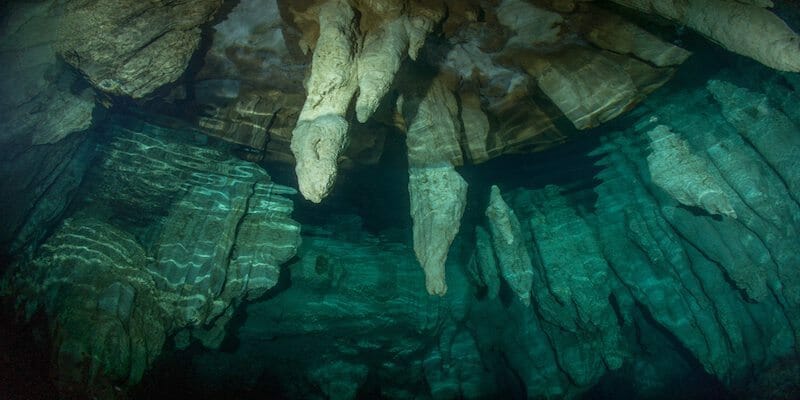 Underwater visibility in the caves is normally fantastic if the bottom remains undisturbed. Each chamber is filled with the strangest stalactites and limestone formations that have formed over the millennia, and resemble beautiful chandeliers, hence the name Chandelier Cave. In the caves, you can find shrimps and crabs living in the sponges, and if you are lucky, you might even see the elusive Mandarin Fish. Maximum depth for this dive is around 10m. If you turn off your torch, you will first be plunged into complete darkness, but be patient and after a couple of minutes, the entrance to the cave will reveal itself in a faint glow.
Maybe not a dive for people that do not like confined spaces, but definitely an unforgettable one! #7. Helmet Wreck And of course, there is also enough to see for all those of you who like to have a glimpse into the past by exploring wrecks. There are actually quite a few scattered around Palau, but the Helmet Wreck is always a favorite with divers from around the world.
It rests on a slope with the bow deeper than the stern. Maximum depth for this wreck is around 30 m; the uppermost part rests in only 10 m of water. The wreck sits upright on the seafloor and is completely encrusted in various corals. There are a lot of things to see and discover, for example, the gun barrel and gun mount.
Underwater visibility in the caves is normally fantastic if the bottom remains undisturbed. Each chamber is filled with the strangest stalactites and limestone formations that have formed over the millennia, and resemble beautiful chandeliers, hence the name Chandelier Cave. In the caves, you can find shrimps and crabs living in the sponges, and if you are lucky, you might even see the elusive Mandarin Fish. Maximum depth for this dive is around 10m. If you turn off your torch, you will first be plunged into complete darkness, but be patient and after a couple of minutes, the entrance to the cave will reveal itself in a faint glow.
Maybe not a dive for people that do not like confined spaces, but definitely an unforgettable one! #7. Helmet Wreck And of course, there is also enough to see for all those of you who like to have a glimpse into the past by exploring wrecks. There are actually quite a few scattered around Palau, but the Helmet Wreck is always a favorite with divers from around the world.
It rests on a slope with the bow deeper than the stern. Maximum depth for this wreck is around 30 m; the uppermost part rests in only 10 m of water. The wreck sits upright on the seafloor and is completely encrusted in various corals. There are a lot of things to see and discover, for example, the gun barrel and gun mount. 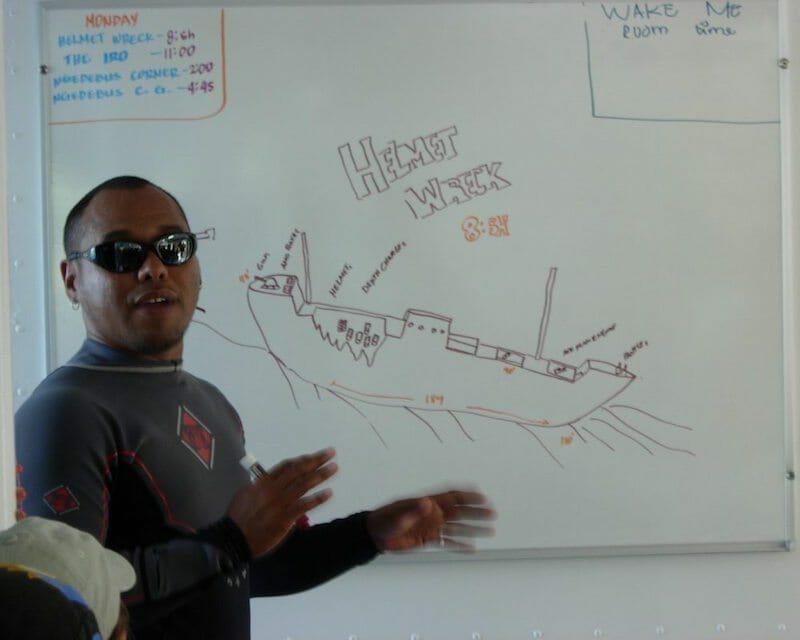 The wreck sits upright on the seafloor and is completely encrusted in various corals. There are a lot of things to see and discover, for example, the gun barrel and gun mount. The small supply vessel has been hit on the starboard side, and the explosion left a massive hole, giving access to the main cargo hold. You will find throughout the wreck, piles of ammunition, rifles, and helmets. These last ones give the wreck its name. The vessels real name is unknown. It was most likely confiscated in South East Asia during WW2. Its wreck was discovered fairly recently in1990 and so far any attempt to find out the ships real name has remained fruitless. The wreck is about 180 feet/60 m long, and 30 feet/10 m wide and remains fairly intact in large areas. It can be penetrated, but of course, you need the proper training and experience. Due to its proximity to the reef and the silty bottom, visibility is not always good. Please take care when diving the wreck and do not pick up any ammunition, etc., since the years in the water have rendered it unstable, and it might explode. #8. The Jellyfish Lake Some people might wonder, why the famous Jellyfish Lake does not feature amongst the best dive sites in Palau. There are a few reasons for that, the most important one, that it is not actually a dive site. Only snorkeling is allowed to preserve the delicate ecosystem of the lake, which has been gravely disturbed by the recent drought, eradicating most of the jellyfish in Jellyfish Lake. It is now until further notice completely closed for touristic traffic. Luckily, Palau has so much more to offer! Only snorkeling is allowed to preserve the delicate ecosystem of the lake, which has been gravely disturbed by the recent drought in 2016, killing most of the jellyfish in Jellyfish Lake. The lake and jellyfish are slowly recovering, time will tell if it makes a full reovery. Luckily, Palau has so much more to offer!
The wreck sits upright on the seafloor and is completely encrusted in various corals. There are a lot of things to see and discover, for example, the gun barrel and gun mount. The small supply vessel has been hit on the starboard side, and the explosion left a massive hole, giving access to the main cargo hold. You will find throughout the wreck, piles of ammunition, rifles, and helmets. These last ones give the wreck its name. The vessels real name is unknown. It was most likely confiscated in South East Asia during WW2. Its wreck was discovered fairly recently in1990 and so far any attempt to find out the ships real name has remained fruitless. The wreck is about 180 feet/60 m long, and 30 feet/10 m wide and remains fairly intact in large areas. It can be penetrated, but of course, you need the proper training and experience. Due to its proximity to the reef and the silty bottom, visibility is not always good. Please take care when diving the wreck and do not pick up any ammunition, etc., since the years in the water have rendered it unstable, and it might explode. #8. The Jellyfish Lake Some people might wonder, why the famous Jellyfish Lake does not feature amongst the best dive sites in Palau. There are a few reasons for that, the most important one, that it is not actually a dive site. Only snorkeling is allowed to preserve the delicate ecosystem of the lake, which has been gravely disturbed by the recent drought, eradicating most of the jellyfish in Jellyfish Lake. It is now until further notice completely closed for touristic traffic. Luckily, Palau has so much more to offer! Only snorkeling is allowed to preserve the delicate ecosystem of the lake, which has been gravely disturbed by the recent drought in 2016, killing most of the jellyfish in Jellyfish Lake. The lake and jellyfish are slowly recovering, time will tell if it makes a full reovery. Luckily, Palau has so much more to offer!  Please feel free to contact us directly if you have any questions. We would love to hear from you.
Please feel free to contact us directly if you have any questions. We would love to hear from you.
